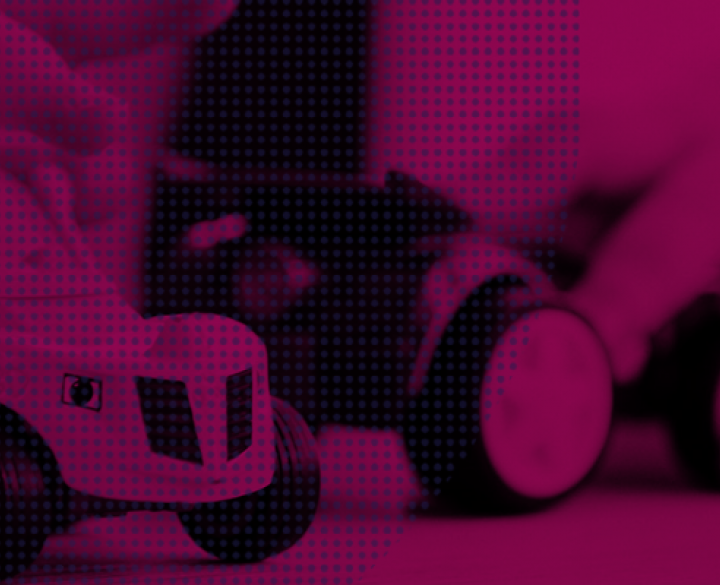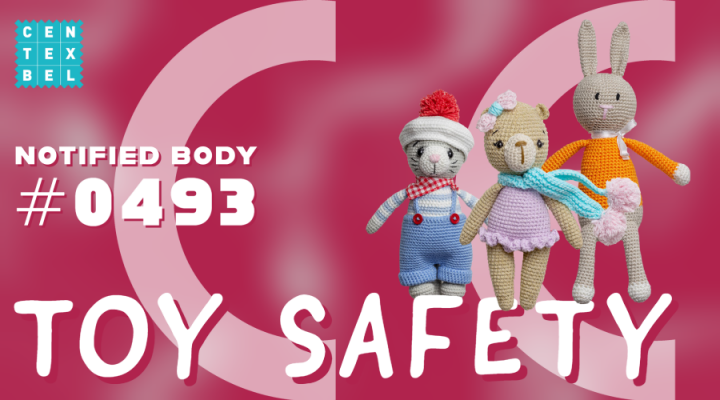All toys that are sold in the European Union must bear the CE mark, indicating that they comply with the applicable legislation.
The EU Toy Safety Directive 2009/48/EC outlines the rules on the safety of toys and on their free movement in the Community.
We will guide you through the CE marking process of toys by means of 4 questions and answers!
Further reading
- the determination of chemical components (EN 71-3)
- detection and analysis of the most common organic chemical components (EN 71-9,10 & 11)
- burning behaviour tests (EN 71-2)
- mechanical tests (EN 71-1) on toys
- laundry tests on children’s and baby’s articles.
1. Is my product a toy?
The Toys Safety Directive applies to products designed or intended, whether or not exclusively, for use in play by children under 14 years of age (hereinafter referred to as toys). This means that a product does not have to be exclusively intended for play to be considered a toy. For example, a keyring with a stuffed animal is considered a toy and falls under the scope of the directive.
The Toys Safety Directive does NOT apply to the following toys:
- playground equipment intended for public use
- automatic playing machines, whether coin operated or not, intended for public use
- toy vehicles equipped with combustion engines
- toy steam engines
- slings and catapults
The following articles are also excluded from the scope:
- products intended for collectors aged 14 and older
- sports equipment
- scooters and other means of transport
- puzzles with more than 500 pieces
- educational products for teaching purposes
- fashion accessories for children
If you are not sure whether your product is a toy, consult Toy Safety Directive 2009/48/EC (you will find a complete list of products that are not considered as toys in Annex I) or ask our product certifiers!
2. How to CE mark a toy?
Once you have determined that your product is a toy, it must meet the requirements defined by Toys Safety Directive 2009/48/EC to enter the EU market. The CE marking procedure for toys includes defining the intended use, carrying out conformity assessments, safety testing, compiling a technical file, drafting a Declaration of Conformity and applying the CE mark.
The following tests are important:
- Defining mechanical and physical properties – EN 71-1
- Testing for flammability – EN 71-2
- Testing for chemicals – EN 71-3
The specific testing procedures and documentation needed for CE marking a toy depend on the features of your product.
If you are unsure what kind of testing or documentation you need to CE mark your toy, contact us. Our experts will guide you through the CE marking procedures.
3. When do I need the assistance of a notified body?
In the following cases, the toy shall be submitted to a notified body to perform an EC-type examination (module B), together with the conformity to type procedure set out in Module C of Annex II to Decision No 768/2008/EC:
- in the absence of harmonised standards, covering all relevant safety requirements for the toy
- when such harmonised standards do exist, but the manufacturer has not applied them or has applied them only in part
- where one or more of such harmonised standards have been published with a restriction
- when the manufacturer considers that the nature, design, construction, or purpose of the toy necessitates third-party verification
After consultation with the applicant, the EC type-examination shall be carried out. This verification is guided by the technical file, based on the requirements of Directive 2009/48/EC, in particular Annex II thereof, and the harmonised standards or other technical specifications used.
The manufacturer shall submit to the notified body the following documents:
- technical documentation (the application for EC type examination shall include a description of the toy and an indication of the place of manufacture, including the address)
- evidence of the adequacy of the technical design
- required samples representative of the production in question
During this examination, prototypes are also subjected to the tests provided for in the relevant harmonised standard or technical specification. These tests are performed in the CENTEXBEL laboratories or by an approved subcontractor in accordance with the requirements of ISO 17025.
What does a Notified body do?
- checking the conformity of the toy with the essential requirements
- examining the technical documentation and supporting evidence to assess the adequacy of the technical design
- if needed, carrying out tests on one or more representative samples of one or more critical parts of the product (combination of production type and design type)
- granting the EC-type examination certificate
4. When can I sell my toys in the European Union?
By drafting a Declaration of Conformity and applying the CE mark, you are declaring that your toy meets EU requirements for health and safety and that it can therefore be sold in Europe.
Is your company based in the EU?
Then you can begin trading your product when the CE certification is completed.
Are you a non-EU manufacturer or e-commerce seller?
Then you must have an Authorised Representative to verify your CE marking before you can sell your product in Europe.
Read more on the Regulation (EU) 2019/1020 of the European Parliament and of the Council of 20 June 2019 on market surveillance and compliance of products.





